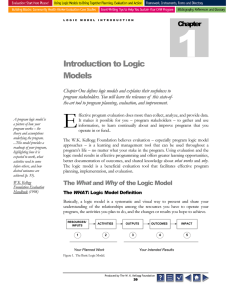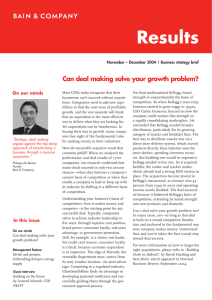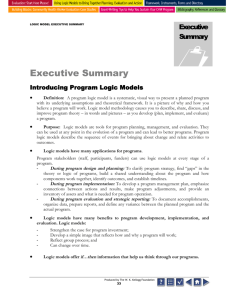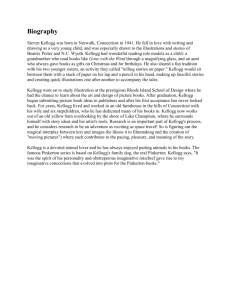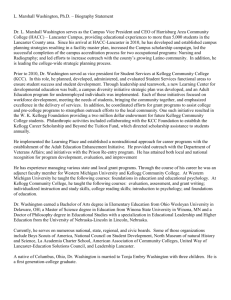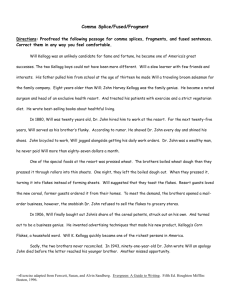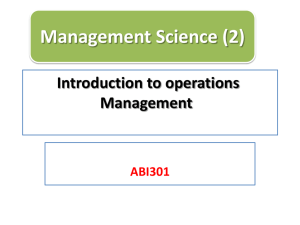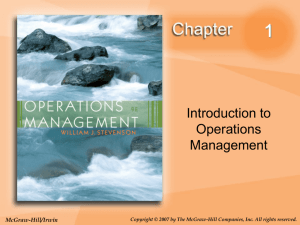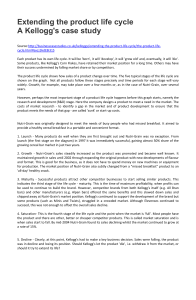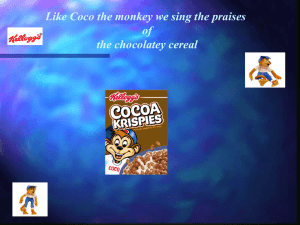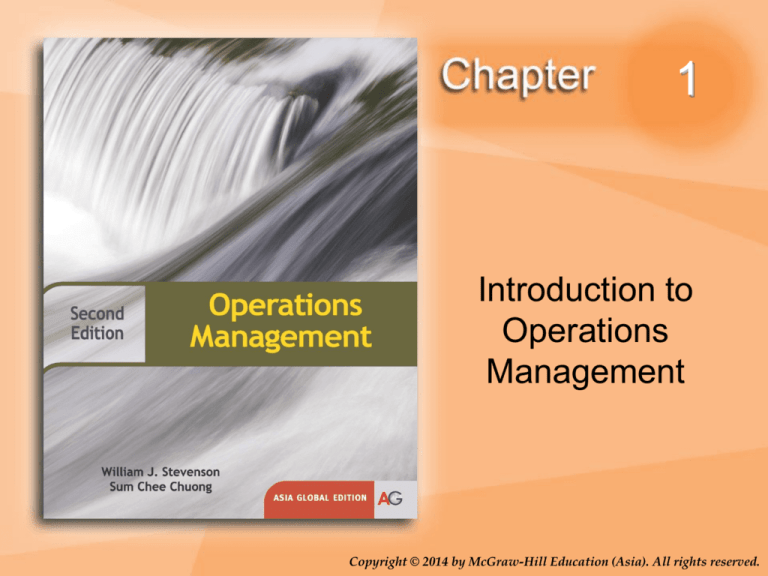
1
Introduction to
Operations
Management
Copyright © 2014 by McGraw-Hill Education (Asia). All rights reserved.
Learning Objectives
Define the term operations management
Identify the three major functional areas of
organizations and describe how they
interrelate
Compare and contrast service and
manufacturing operations
Describe the operations function and the
nature of the operations manager’s job
1-2
Learning Objectives
Differentiate between design and operation
of production systems
Describe the key aspects of operations
management decision making
Briefly describe the historical evolution of
operations management
Identify current trends that impact operations
management
1-3
Kellogg’s Company
Maker of popular cereal, breakfast, and
snack products, such as Kellogg’s Corn
Flakes, Rice Krispies, Raisin Bran, PopTarts, Eggo Waffles, and Nutri-grain bars
Founded in 1906 in Battle Creek,
Michigan, by W. K. Kellogg.
Adhere to strong quality standards and
developing new technologies, such as
Waxtite wrappers to keep cereal fresh for
long periods of time.
Figure 1.1: Kellogg’s 2006
Sales Around the World (in $ billions)
Kellogg’s Company
The supply chain consists of 27
manufacturing plants in the United States
and 19 plants in 15 countries around the
world, including Australia, Mexico, India,
Brazil, and Japan.
Key operations decisions must be made
throughout Kellogg’s network of plants.
Kellogg’s Company
The product mix to manufactured at each plant
must decided – example should every plant
make every product or should plants be
specialized and focus
Is it better for Kellogg's to work with smaller,
local suppliers for each plant or with larger,
national or international suppliers?
Inventory decisions and policies must be set
for each plant, each distribution center, and
each retailer that Kellogg's’ runs, works with,
or sells to.
1-7
Operations Management
Operations Management is:
The management of systems or processes
that create goods and/or provide services
Operations Management affects:
Companies’ ability to compete
Nation’s ability to compete internationally
1-8
The Organization
Figure 1.1
The Three Basic Functions
Organization
Finance
Operations
Marketing
1-9
Value-Added Process
Figure 1.2
The operations function involves the conversion of
inputs into outputs
Value added
Inputs
Land
Labor
Capital
Transformation/
Conversion
process
Outputs
Goods
Services
Feedback
Control
Feedback
Feedback
1-10
Value-Added and Product Packages
Value-added elements make the difference
between the cost of inputs and the value or
price of outputs.
Product packages are a combination of
goods and services.
Product packages can make a company
more competitive.
1-11
The Goods–Service Continuum
Figure 1.3
Goods
Service
Surgery, teaching
Song writing, software development
Computer repair, restaurant meal
Automobile repair, fast food
Home remodeling, retail sales
Automobile assembly, steel making
1-12
Food Processor
Table 1.2
Inputs
Processing
Outputs
Raw vegetables
Metal sheets
Water
Energy
Labor
Building
Equipment
Cleaning
Making cans
Cutting
Cooking
Packing
Labeling
Canned
vegetables
1-13
Hospital
Table 1.2
Inputs
Doctors, nurses
Hospital
Medical supplies
Equipment
Laboratories
Processing
Outputs
Examination
Surgery
Monitoring
Medication
Therapy
Treated
patients
1-14
Manufacturing or Service?
Tangible
Act
1-15
Production of Goods
vs. Delivery of Services
Production of goods – tangible output
Delivery of services – an act
Service job categories
Government
Wholesale/retail
Financial services
Healthcare
Personal services
Business services
Education
1-16
Key Differences
1.
2.
3.
4.
5.
Customer contact
Uniformity of input
Labor content of jobs
Uniformity of output
Measurement of productivity
1-17
Key Differences
6. Production and delivery
7. Quality assurance
8. Amount of inventory
9. Evaluation of work
10. Ability to patent design
1-18
Table 1.3
Goods vs. Service
Characteristic
Goods
Service
Customer contact
Uniformity of input
Labor content
Low
High
Low
High
Low
High
Uniformity of output
High
Low
Output
Measurement of productivity
Opportunity to correct problems
Inventory
Tangible
Easy
High
Much
Intangible
Difficult
Low
Little
Evaluation
Patentable
Easier
Usually
Difficult
Not usually
1-19
Scope of Operations Management
Operations Management includes:
Forecasting
Capacity planning
Scheduling
Managing inventories
Assuring quality
Motivating and training employees
Locating facilities
Supply chain management
And more . . .
1-20
Types of Operations
Table 1.4
Operations
Examples
Goods Producing
Farming, mining, construction,
manufacturing, power generation
Storage/Transportation Warehousing, trucking, mail
service, moving, taxis, buses,
hotels, airlines
Exchange
Retailing, wholesaling, financial
advising, renting or leasing
Entertainment
Films, radio and television,
concerts, recording
Communication
Newspapers, radio and TV
newscasts, telephone, satellites
1-21
Key Decisions of Operations Managers
What
What resources/what amounts
When
Needed/scheduled/ordered
Where
Work to be done
How
Designed/Resources allocated
Who
To do the work
1-26
Overlap of Business Functions
Figure 1.5
Operations
Finance
Marketing
1-38
Operations Interfaces
Figure 1.6
Legal
Public
Relations
Accounting
Operations
Personnel/
Human
resources
MIS
1-39
Historical Summary of
Operations Management
Industrial revolution (1770s)
Scientific management (1911)
Mass production
Interchangeable parts
Division of labor
Human relations movement (1920–60)
Decision models (1915, 1960–’70s)
Influence of Japanese manufacturers
1-40

